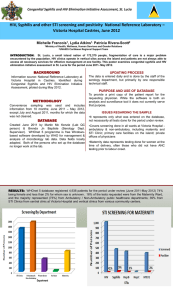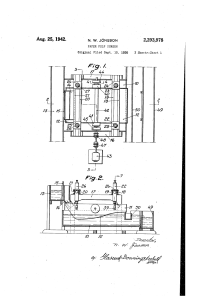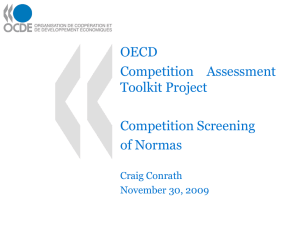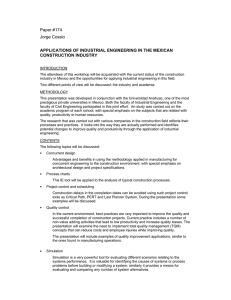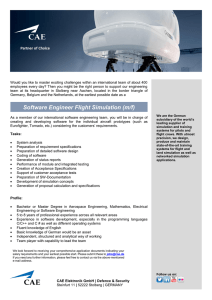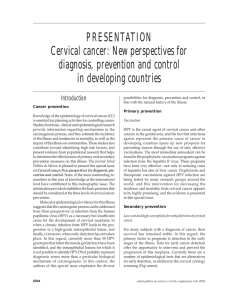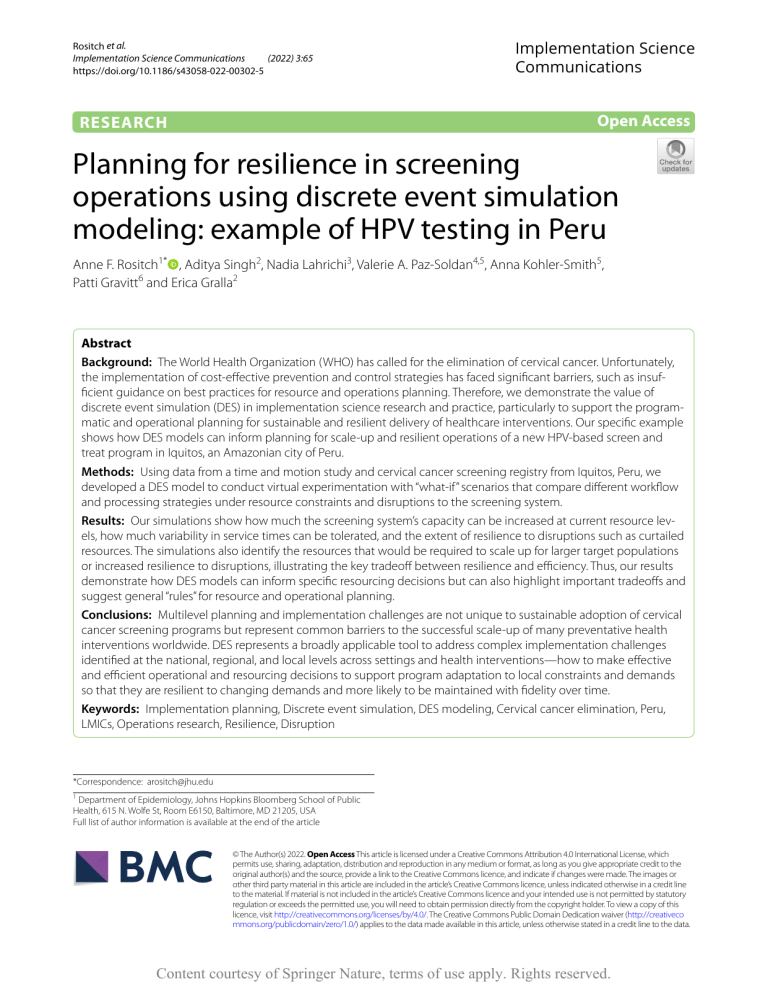
Rositch et al. Implementation Science Communications (2022) 3:65 https://doi.org/10.1186/s43058-022-00302-5 Implementation Science Communications Open Access RESEARCH Planning for resilience in screening operations using discrete event simulation modeling: example of HPV testing in Peru Anne F. Rositch1* , Aditya Singh2, Nadia Lahrichi3, Valerie A. Paz‑Soldan4,5, Anna Kohler‑Smith5, Patti Gravitt6 and Erica Gralla2 Abstract Background: The World Health Organization (WHO) has called for the elimination of cervical cancer. Unfortunately, the implementation of cost-effective prevention and control strategies has faced significant barriers, such as insuf‑ ficient guidance on best practices for resource and operations planning. Therefore, we demonstrate the value of discrete event simulation (DES) in implementation science research and practice, particularly to support the program‑ matic and operational planning for sustainable and resilient delivery of healthcare interventions. Our specific example shows how DES models can inform planning for scale-up and resilient operations of a new HPV-based screen and treat program in Iquitos, an Amazonian city of Peru. Methods: Using data from a time and motion study and cervical cancer screening registry from Iquitos, Peru, we developed a DES model to conduct virtual experimentation with “what-if” scenarios that compare different workflow and processing strategies under resource constraints and disruptions to the screening system. Results: Our simulations show how much the screening system’s capacity can be increased at current resource lev‑ els, how much variability in service times can be tolerated, and the extent of resilience to disruptions such as curtailed resources. The simulations also identify the resources that would be required to scale up for larger target populations or increased resilience to disruptions, illustrating the key tradeoff between resilience and efficiency. Thus, our results demonstrate how DES models can inform specific resourcing decisions but can also highlight important tradeoffs and suggest general “rules” for resource and operational planning. Conclusions: Multilevel planning and implementation challenges are not unique to sustainable adoption of cervical cancer screening programs but represent common barriers to the successful scale-up of many preventative health interventions worldwide. DES represents a broadly applicable tool to address complex implementation challenges identified at the national, regional, and local levels across settings and health interventions—how to make effective and efficient operational and resourcing decisions to support program adaptation to local constraints and demands so that they are resilient to changing demands and more likely to be maintained with fidelity over time. Keywords: Implementation planning, Discrete event simulation, DES modeling, Cervical cancer elimination, Peru, LMICs, Operations research, Resilience, Disruption *Correspondence: arositch@jhu.edu 1 Department of Epidemiology, Johns Hopkins Bloomberg School of Public Health, 615 N. Wolfe St, Room E6150, Baltimore, MD 21205, USA Full list of author information is available at the end of the article © The Author(s) 2022. Open Access This article is licensed under a Creative Commons Attribution 4.0 International License, which permits use, sharing, adaptation, distribution and reproduction in any medium or format, as long as you give appropriate credit to the original author(s) and the source, provide a link to the Creative Commons licence, and indicate if changes were made. The images or other third party material in this article are included in the article’s Creative Commons licence, unless indicated otherwise in a credit line to the material. If material is not included in the article’s Creative Commons licence and your intended use is not permitted by statutory regulation or exceeds the permitted use, you will need to obtain permission directly from the copyright holder. To view a copy of this licence, visit http://creativecommons.org/licenses/by/4.0/. The Creative Commons Public Domain Dedication waiver (http://creativeco mmons.org/publicdomain/zero/1.0/) applies to the data made available in this article, unless otherwise stated in a credit line to the data. Content courtesy of Springer Nature, terms of use apply. Rights reserved. Rositch et al. Implementation Science Communications (2022) 3:65 Contributions to the literature • While decision-analytic modeling has proven critical for the adoption of new technologies, our discrete event simulation (DES) models focus on the next set of decisions: resources and operations critical to adequate delivery of services. • As an example, for an HPV-based screening program, our results assess its resilience to variability and disruption and the resources required to scale up capacity. • These operational aspects of implementation have received limited attention but are critical in moving evidence-based interventions into routine practice. • Thus, we demonstrate that DES models fill an essential and neglected role in translating new technologies and interventions into practice. Introduction The World Health Organization (WHO) has called for the elimination of cervical cancer through accelerated implementation of cost-effective prevention and control strategies, including screening with the treatment of precancerous lesions [1]. Low- and middle-income countries (LMICs), which bear the largest burden of cervical cancer and currently have either no, or highly ineffective, screening programs, can meet this global call to action only if significant efforts are made to adopt screening programs designed specifically for resource-limited settings [2]. Thus, the WHO guidelines now suggest choosing among several cost-effective screening strategies based on the availability of resources. Although many countries have adopted one or more of these WHO-recommended strategies in their national cancer control plans [3–5], implementation of the new strategies has faced significant barriers, slowing the translation of policy to real-world practice [3, 6]. Unless these implementation challenges are adequately addressed, cervical cancer elimination goals will not be met, resulting in millions of preventable deaths. Once a screening strategy has been adopted into a national screening program, a major barrier to successful implementation, scale-up and sustainment of cervical cancer prevention programs has been insufficient guidance on best practices for resource and operations planning. “Resource and operations planning” is the set of decisions required to implement a screening approach, such as determining the amount and allocation of staff and equipment and how and when to transport samples and results. Uninformed choices in resourcing and operations risk causing early failures in Page 2 of 13 implementation, leading to reduced enthusiasm for new programs and even reversion to previous ineffective program plans. While these choices are often treated informally, we can facilitate data-driven resource planning and decision-making by “virtual experimentation” to examine the alternative implementation strategies using discrete event simulation (DES). DES models have been used extensively in industrial engineering and in healthcare to improve operational efficiency and effectiveness by simulating "what-if " scenarios before investing in process changes [7–16], including in screening applications [8, 11] and in other applications in LMIC countries [17, 18]. DES models can represent health service systems by modeling patients, samples, and other entities as they move through a process [19]. A process consists of a series of steps such as registration, sample collection, sample testing, and results delivery. The representation is sufficiently detailed to simulate interactions among patients/samples through resource-constrained process steps. For example, by simulating all the patients and samples as they step through the process, a DES model can measure the queues that result when patients wait to see a busy doctor and compute how long samples wait to be processed by a laboratory. By modeling the complex dynamics that lead to these bottlenecks and unintended consequences, DES models can explore the relative impact of both high-cost solutions such as building new physical space or hiring new staff against lower cost solutions such as workflow redesign and patient/staff scheduling. These examples are analogous to decisions facing LMIC stakeholders weighing the desirability of increasing coverage of cervical cancer screening and follow-up against the feasibility of meeting the new demand without a significant increase in resources. The overarching goal of this project is to demonstrate the value of DES in implementation research and practice, particularly to support operational planning for sustainable and resilient delivery of healthcare interventions. While we apply DES to guide decision-making and resource utilization for cervical cancer prevention programs, these multi-level planning and implementation challenges represent common barriers to the successful scale-up of many preventative health interventions worldwide. DES represents a broadly applicable tool to address complex implementation challenges across settings and health interventions—how to make effective and efficient operational and resourcing decisions to support program adaptation (i.e., make more suitable) to local constraints in order to foster fidelity and resiliency. Content courtesy of Springer Nature, terms of use apply. Rights reserved. Rositch et al. Implementation Science Communications (2022) 3:65 Page 3 of 13 Fig. 1 Process for HPV screen and treat, as represented in the DES model. Data estimated from a time and motion study, b electronic screening registry, and c direct observation Methods The Peruvian context and data In Iquitos, a city of ~ 400,000 in the northern Amazon basin region of Peru, we conducted a participatory action research study to develop, implement, and test stakeholder-driven strategies for cervical cancer screening and treatment [20]. As part of this Proyecto Precancer Study, a difficult barrier emerged: making effective and efficient operational and resourcing decisions so that the new screening program is better adapted to the local constraints and demand. Available tools from the WHO [21, 22] were essential in identifying “what” to do but provided insufficient guidance for “how” to do it. To support such decisions, we decided to build a DES model of the screening process to carry out virtual experiments to assess the screening system’s performance at various resource levels. As part of the Proyecto Precancer Study, we carried out a process mapping exercise [23, 24] whereby multilevel stakeholders, including obstetras, doctors, colposcopists, administrators, and health authorities from the regional Ministry of Health, visually outlined and expanded upon the major steps and processes in the newly developed HPV-based screen and treat program for cervical cancer prevention. The process map (Fig. 1) was then used to build a simulation model, which was parameterized with real-life data from a time and motion study and screening registry. As part of a time and motion study, we collected informed consent from patients and providers to directly observe and record time spent on different in-clinic activities and procedures at the major steps along the HPV-based screen and treat program process; data were collected at three clinics over 14 days (Appendix). For screening, we recorded the following times (in minutes): patient arrival, pre-screening registration and counseling, and HPV sample collection (clinician or self-collection). For the follow-up visit, we recorded the following times: arrival; pre-treatment registration, counseling, and consent; visual examination to determine thermal ablation (TA) eligibility; TA procedure; post-treatment counseling; and disinfection of TA probes. For HPV laboratory testing, we used direct observation to measure time (in minutes) for sample accessioning, processing, testing, and recording of results. We used our electronic screening registry to estimate the turnaround time (in days) from sample collection to HPV test completion in the central laboratory and from HPV result availability to conduct of visual triage to treatment (VTT) examination (for HPV positive women). Positivity rates, patient arrival rates, follow-up losses, and excision requirement rates were also estimated from the electronic screening registry. Content courtesy of Springer Nature, terms of use apply. Rights reserved. Rositch et al. Implementation Science Communications (2022) 3:65 Page 4 of 13 The discrete event simulation model A DES model was created to represent the process maps generated by multi-level stakeholders in Iquitos (Fig. 1). The movement of patients and samples is simulated as they move through the process steps. Each step (shown in orange in Fig. 1) takes some amount of time to complete (a stochastic value drawn from a distribution) and has a fixed capacity (such as two staff who can process parallel registrations or an instrument with four testing wells). When a patient or sample finishes one step, it waits until the next step is available, potentially generating a queue if the next step remains busy. When the process branches—such as when a test may be positive or negative—the branch is chosen by drawing from a probability distribution. Thus, running the model simulates realistic variations in patient arrivals, queues, activity durations, and outcomes, accounting for the resource constraints in all parts of the modeled system. The parameters for the model are designed to represent the process implemented in Iquitos. Processing time distributions are estimated from the time and motion study and the screening registry by fitting a distribution to the data (Appendix). In all cases, either a triangular or PERT distribution (based on the beta distribution and defined by the minimum, most likely, and maximum values of a variable) [25] was chosen because it provided a good fit based on the Kolmogorov–Smirnov test and is easily interpretable. The inputs and assumptions for the simulation model are described in Table 1. The model was verified to ensure that it accurately represented the processes mapped by stakeholders, through detailed examination and by testing for reasonable outputs in a range of standard and extreme input parameters. Since the process has not yet been fully implemented in Iquitos, we followed the same approach as previous authors [16, 26]: the model was validated through stakeholder consultations instead of against data from Iquitos. Specifically, stakeholders were consulted through workshops in which they participated in the initial process mapping and later reviewed, refined, and approved the final process maps. Stakeholders were also shown the modeling results in a presentation and asked whether the results matched their experience with the processes. It is also important to note that the first part of the process, from sample collection to HPV testing, was fully implemented but with inconsistent processes and levels of demand, while the second part of the process was in a pilot phase. The model was implemented in SIMIO version 11, an industry standard software package for this type of simulation. Simulating health system performance under various scenarios The model enables “virtual experiments” that evaluate the screening system’s performance under hypothetical “what-if ” scenarios. Each scenario represents a potential change in the screening system’s resources, such as more staff or fewer operating hours. These virtual experiments allow decision-makers to evaluate the screening system’s adequacy to meet planned targets and its resilience to change and to test potential resourcing approaches, providing a basis for informed, data-driven implementation plans. Specifically, the performance of the health system is estimated in four experiments to investigate: (1) how many women can be screened with the baseline level of resources, (2) the resilience of the screening system to changes that make process steps take longer or take less predictable amounts of time, (3) the resources that would be required to scale up to meet a higher demand for screening, and (4) the resilience of the screening system to larger disruptions such as unavailable equipment or personnel. The baseline scenario represents the current status of the screening system. In virtual experiments, the assumptions are varied from the baseline to represent a set of “what-if ” scenarios, such as higher demand or slower Table 1 Baseline scenario assumptions Parameter Assumption Central lab testing capacity Two 4-well GeneXpert machines can process up to eight samples at one time. Central lab testing time (for sample analysis and results processing) Triangular distribution in which the most likely value (central parameter) is 65 min to complete the testing process and output the results; 5 min for results processing (see the Appendix section for all the parameters of the distribu‑ tion). Scheduled hours of operation for CxCa screening 3 h per day, 5 days per week. Demand for screening 4000 women per year, with Poisson-distributed arrival times. Batching for transport Samples are collected, stored, and sent from a health center to the central lab once a week on Wednesdays; results are returned on the same schedule. Additional processing times See the Appendix section for additional processing time parameters. Content courtesy of Springer Nature, terms of use apply. Rights reserved. Rositch et al. Implementation Science Communications (2022) 3:65 processing times. The baseline scenario assumptions are provided in Table 1. Each experiment includes a series of “what-if ” scenarios, which each change one or more of the baseline assumptions, as shown in Table 2. For example, to investigate the consequences of higher demand, one parameter (demand) is varied to create three “whatif ” scenarios, which increase the demand from the baseline of 4000 to 4700, 5500, and 6000 women per year. Outcome measures To compare scenarios, several measures of performance, or key performance indicators (KPIs), are defined based on the goals and constraints of the screening system. These measures are as follows: 1. Number of women screened per year 2. Maximum time between sample collection and sample testing 3. Percent utilization of key resources The first performance measure evaluates how well the screening system meets its goal to screen and treat the target population. It is computed by measuring the number of women whose results are reported, in the full year of simulated operations. The second measure tests whether the screening system meets a key constraint: the maximum time a sample spends in the system must not be greater than 14 days, or it expires and cannot be used (according to the HPV test manufacturer). It is computed by measuring the amount of time every sample spends Page 5 of 13 from collection until testing, then finding the maximum across all the simulated samples. The third measure helps to identify parts of the process that are under-resourced or over-resourced by measuring how frequently a resource is being utilized, as a percentage of its scheduled time available. Specifically, percent utilization is defined as the percentage of a resource’s scheduled available time that is actively spent doing a process. For example, if a resource is scheduled to be available for 8 h a day and the resource is actively used for 4 h, then percent utilization would be 50%. When a process step’s utilization approaches 100%, it becomes a bottleneck and limits flow through the system. Identifying bottlenecks reveals the capacity limit of the screening system and shows where more resources are needed if capacity is to be expanded or resilience is to be enhanced. The KPIs are computed by the model over one full year of screening operations, which is sufficient to capture all relevant variability and seasonality. This 1-year period was determined by comparing the performance of the model for 2 and 3 years, which produced equivalent results. Because the model parameters (such as processing times) are drawn from a distribution, the KPIs also vary for each simulation run. Therefore, each “whatif ” scenario is simulated 100 times, and the results are reported as a box plot in which the median line, interquartile range box, range line, and outlier marks are shown. This number of repetitions was determined after a comparison of the results with those from 300 and 500 repetitions. Table 2 Detail of the "what-if" scenarios Experiment Description Screening system capacity with baseline resources (Figs. 2 and 3) Assess capacity to meet the increas‑ Demand for screening ing demand for screening 4000*, 4700, 5500, 6000 women per year Resilience to changes in processing times (Fig. 4) Assess resilience to longer or more variable processing times Most likely central lab testing time (central parameter of triangular distribution) Multiplied by a factor of 1*, 1.5, 2, and 3 Maximum central lab testing time (last parameter of triangular distribution) Multiplied by a factor of 1*, 1.5, 2, and 3 Demand for screening 9500 Scheduled hours of operation for CxCa screening per day (assumes 5 days per week) 3*, 4, 5, and 6 Central lab testing capacity (num‑ ber of GeneXpert testing wells) 8* and 12 Scheduled hours of operation for CxCa screening per day (assumes 5 days per week) 3*, 2, and 1 Central lab testing capacity (num‑ ber of GeneXpert testing wells) 4, 8*, and 12 Scaling up to meet a higher demand (Fig. 5) Resilience to disruptions (Fig. 6) Identify the resources required to meet a higher demand of 9500 women per year Assess resilience to disruptions which result in cuts in laboratory operating hours or testing machine availability Parameters varied Values in "what-if" scenarios (* indicates baseline value) Content courtesy of Springer Nature, terms of use apply. Rights reserved. Rositch et al. Implementation Science Communications (2022) 3:65 Page 6 of 13 Fig. 2 Maximum time from sample collection to testing, with baseline resource levels and increasing demand. For each "what-if" scenario (point on the x-axis), results from 100 simulation runs are reported on a box plot showing the median (horizontal line), interquartile range (box), range (whiskers), and outliers (asterisks) Results The following sections describe each of the four virtual experiments, described above and summarized in Table 2. Screening system capacity with baseline resources A fundamental question is whether the screening system has the capacity to meet the target demand for screening. In addition, this target could change—if, for example, the population increases, the coverage area expands, or more women choose to be screened in one year. Therefore, various levels of screening demand were simulated to determine the capacity of the screening system with its baseline level of resources. Figure 2 shows the maximum time that any sample spends in the system for scenarios with different yearly demand levels. Recall that the samples must spend less than 14 days between collection and testing. Figure 2 shows that the screening system is able to reliably meet the baseline demand (4000 women per year) without samples waiting more than 14 days, but for higher demand, the wait times increase slowly and then rapidly when demand rises to 6000 per year. Based on these results, the screening system’s maximum capacity is around 4700 women per year. This leaves little room for expansion of coverage with current resources. The models also enable us to examine the “bottlenecks” in the screening system—the process steps whose capacity limits the overall capacity of the system. The stakeholders believe, and our analysis confirms, that the central laboratory is the main bottleneck, since all samples from all 17 health centers must be processed there. The central laboratory has two key resources: the GeneXpert machine that runs the test on the samples and the technician who transcribes the GeneXpert output into a result that can be easily interpreted by workers and patients at the health centers. Analyzing how “busy” these resources are thus provides insight into the screening system’s performance as demand increases. Figure 3 shows the percent utilization for each of these central laboratory resources. Percent utilization refers to the percentage of time that the machine is running (or busy) during the time that the machine is scheduled to run. (For example, if a machine runs 3 h per day and sits Content courtesy of Springer Nature, terms of use apply. Rights reserved. Rositch et al. Implementation Science Communications (2022) 3:65 Page 7 of 13 Fig. 3 Percent utilization of two central lab resources, the GeneXpert and the laboratory technician’s time transcribing its results, with baseline resource levels and increasing demand. For each "what-if" scenario (point on the x-axis), results from 100 simulation runs are reported on a box plot showing the median (horizontal line), interquartile range (box), range (whiskers), and outliers (asterisks) idle for 3 h a day during a 6 h scheduled availability time, then the percent utilization rate would be 50%.) For the GeneXpert machine, utilization grows from a comfortable 70% for the target demand to an unmanageable 100% for the highest demand of 6000 women per year. This helps to explain the previously observed large growth in the time a sample spends waiting: the GeneXpert machine is always busy, causing samples to pile up waiting while the machine tries to work through a growing backlog. This high utilization indicates that the GeneXpert is acting as a bottleneck, limiting the capacity of the overall screening system. Resilience to changes in processing times Processing times were measured based on the current screening system operations, but they might change if, for example, new employees perform them or a process is rolled out to new locations. Therefore, the screening system performance is analyzed for processing times that are longer (average processing time increases) and for processing times that are more variable (wider distribution around the mean). Because the central laboratory is the main bottleneck, we changed the processing times for the result transcription step, which is performed by a laboratory technician after the sample is analyzed in the GeneXpert. (The GeneXpert machine processing time is not heavily influenced by human behavior and is thus less susceptible to human error, so it was left constant.) The baseline demand of 4000 people is used throughout these scenarios. The left side of Fig. 4 shows that, as expected, longer processing times lead to increasing utilization for the results transcription step. The right side of Fig. 4 shows similar but slower increases when processing times become more variable, because in this case, some samples will take much longer to process but some will also take much less time. This analysis can provide a tolerance limit on processing times for key steps. If result transcription takes twice as long, then the screening system performance is still tolerable, but if it takes three times longer than expected, a rapid performance degradation occurs because the scheduled utilization of a bottleneck process reaches 100%. Scaling up to meet a higher demand The models can also provide decision-makers with information on how to scale up a system’s capacity to meet a higher demand. The scaled-up demand scenario Content courtesy of Springer Nature, terms of use apply. Rights reserved. Rositch et al. Implementation Science Communications (2022) 3:65 Page 8 of 13 Fig. 4 Percent utilization of the bottleneck resource, the laboratory technician’s time transcribing results, as processing times grow longer (left side) or more variable (wider; right side). For each "what-if" scenario (point on the x-axis), results from 100 simulation runs are reported on a box plot showing the median (horizontal line), interquartile range (box), range (whiskers), and outliers (asterisks) analyzed here is 9500 people per year, more than double that of the baseline demand scenario (4000). Since the central laboratory is the rate-limiting step for this screening system, and analysis has already shown its capacity to be about 4700, meeting a higher demand requires increasing the number of lab resources, such as operating hours or testing wells. Specifically, the following scenarios explore increasing the number of hours in which the lab is scheduled to process cervical cancer samples, and/or increasing the number of testing wells from 8 to 12 (corresponding to one additional GeneXpert machine). Figure 5 shows the percent utilization of the bottleneck resource, the GeneXpert. With the current GeneXpert capacity of 8 testing wells, adding 1 or even 2 h of lab time (increases of 33% or 66% of capacity) is insufficient to meet the higher demand, since the percent utilization remains near 100% and the sample time from collection to processing remains above 14 days. The lab time must be doubled (to 6 h) to meet the higher demand. If a GeneXpert machine is added (for a total of 12 testing wells), an increase of only 1 h of lab time is required to meet the demand. Thus, if decision-makers want to more than double the target screening capacity, they have multiple options: they may significantly increase operating hours, or they may purchase additional GeneXpert machines and modestly increase operating hours. A third alternative is to implement a batched testing platform with a higher capacity; in future work, a modified DES model could identify the threshold at which the increased demand makes batch processing efficient rather than wasteful. Resilience to disruptions Models can also enable decision-makers to quickly understand the potential impact of disruptions on health system performance. For example, GeneXpert machines or lab time may need to be diverted away from cervical cancer screenings toward a more immediate public health need in the case of an outbreak, such as COVID-19 or TB. In such cases, the availability of the lab technicians and/or the GeneXpert machines for cervical cancer screening might decrease. Figure 6 Content courtesy of Springer Nature, terms of use apply. Rights reserved. Rositch et al. Implementation Science Communications (2022) 3:65 Page 9 of 13 Fig. 5 Percent utilization for various testing (GeneXpert) resource levels (operating hours, number of wells) with scaled-up demand. For each "what-if" scenario (point on the x-axis), results from 100 simulation runs are reported on a box plot showing the median (horizontal line), interquartile range (box), range (whiskers), and outliers (asterisks) shows the impact of cuts in both hours and GeneXpert wells on the time from sample collection to testing (which must not rise above 14 days). The results show that any reduction in GeneXpert machine availability or in the laboratory’s available hours (e.g., due to human resource constraints or diverted resources) would result in unacceptable performance, such that screening targets could not be met. Adding an additional GeneXpert machine would provide some resilience to disruptions, enabling adequate performance with hours cut by 33% (but no more). This small selection of scenarios demonstrates how these models can enable decision-makers to explore the impact of various types of disruptions, so that goals can be adjusted accordingly, or resilience can be built into the health system. Discussion This paper aimed to demonstrate the value of DES in the implementation science research and practice. In this context, data were collected to estimate, for example, sample processing times, but human-involved processes are always susceptible to unexpected changes. Modeling longer and more variable processing times showed worse health system performance and enabled an understanding of the system’s processing time tolerance limits. Health systems are also susceptible to larger disruptions such as curtailed resources (e.g., such as experienced during the COVID-19 pandemic) or increased demand (e.g., such as regional scale-up or screening campaigns). Our results showed that this screening system lacks resilience to both scenarios and identified the resources required to improve performance in such cases. These are valuable but not obvious insights. Our example of HPV-based cervical cancer screening is specific to this setting in Iquitos, Peru, but similar models can be developed for other settings or healthcare delivery interventions. Discrete event simulation provides decision-makers with a powerful tool to work through many potential scenarios and constraints. Decisions on the levels of resources needed to meet various levels of demand are often too Content courtesy of Springer Nature, terms of use apply. Rights reserved. Rositch et al. Implementation Science Communications (2022) 3:65 Page 10 of 13 Fig. 6 Maximum time from sample collection to testing, for various disruption scenarios. For each "what-if" scenario (point on the x-axis), results from 100 simulation runs are reported on a box plot showing the median (horizontal line), interquartile range (box), range (whiskers), and outliers (asterisks) complex to analyze with “back of the envelope” calculations. Similarly, even if decision-makers have a firm understanding of their baseline scenario, they may be unable to accurately predict the effect of a resource disruption or a surge in demand or may even misestimate the severity or timing of such effects. For example, we found that increasing the screening demand by about one quarter could easily be accommodated, but further increases overtaxed the screening system and led to poor performance. Identifying the threshold at which a health system becomes overwhelmed, and the resources required to mitigate this problem is not intuitive, especially in multilevel and interconnected health systems. This paper has demonstrated a few of the ways in which discrete event simulation can mitigate some of these challenges. For the case of HPV-based cervical cancer screening in Peru, our results show that the current pilottested screening system in one micro-network can meet its target capacity. That is, under the current baseline conditions, the screening system has enough capacity to reach the annual target screening goal while maintaining a 14 day results turnaround. However, efforts are now ongoing to scale it up to additional micro-networks, as well as new regions of Peru, which would place a greatly increased demand on the laboratory and potentially on other parts of the screening system. Our results show that additional resources must be devoted to avoid major service disruptions: additional laboratory hours devoted to HPV testing and/or additional testing instruments. Other generalizable real-world scenarios that represent threats to meeting the program goals, such as curtailed/diverted resources or highly variable screening services, showed similar results. Importantly, however, the model also highlights the effect of different tradeoffs such as adding more machines compared to more technician time, thus helping to identify efficient solutions to maintain resilience and sustainability in the dynamic screening system. Moreover, the models can be used to identify any new bottlenecks that may arise, such as the availability of Content courtesy of Springer Nature, terms of use apply. Rights reserved. Rositch et al. Implementation Science Communications (2022) 3:65 precancer treatment providers, as the screening system resources are changed. The insights from this specific case example can be extended in several ways. First, models can be tailored and parameterized to represent other health systems (such as HPV testing in a different region or another type of health service delivery process in the same region). Such a model would support specific decisions on resource levels required to meet changes in the health system, enhance resilience, and/or scale up services to meet increased demand or a broader coverage goal. Second, such specific models could be generalized to represent a broader range of situations (such as HPV testing in any LMIC setting). Such a model would support the development of broader guidelines that identify important tradeoffs, bound resource requirements, and guide the development of implementation plans. Third, the development and validation of the models facilitate stakeholder engagement and shared decision-making across implementation scientists and practitioners to capitalize on their respective expertise in translating interventions sustainably into real-world practice. The use of discrete event simulations is particularly valuable when incorporating a new process into a health system, such as a new technology like COVID-19 testing [27]. For example, while there is clear policy-level guidance on the decision to adopt HPV testing technology [21, 22], much less guidance is available on the operational planning aspects that are critical to effectively and efficiently meeting this demand. As described above, tools such as discrete event simulation models can provide general “rules” or boundaries to inform decisionmaking around the operational aspects of healthcare service delivery. For example, our “what-if ” scenarios demonstrate the importance of balancing resource efficiency against the ability to maintain service resilience to different kinds of disruptions. More specifically, our case demonstrates how the models can support evidencebased decisions on how to plan resources for resilience and/or scale-up. There are several limitations to this study. First, data collection was based on early experiences from one micro-network; thus, continued work in this area will be informative when additional clinics and laboratories can be included, and when similar models can be developed for related settings. While the overall steps in HPV-based screening are similar across most LMIC settings, there are many implementation options to consider, such as batch-testing and point-of-care testing, which were not modeled here, and remain part of our future work. Second, the DES models and “what-if ” scenarios required assumptions about how Page 11 of 13 processes operate or would operate if they were implemented, some of which could not be validated against empirical data. Nevertheless, our results demonstrate how these models lead to useful insights, because they are not intended to be predictive but rather to gauge the relative impact of different process choices on system performance. Data and assumptions from our single empirical setting have already identified key tradeoffs, and future work in different settings could enable the development of more generalizable principles that could be applied more broadly across diverse settings. Conclusions Discrete event simulation models thus fill an essential niche in our arsenal of modeling approaches. Decision analytic modeling has proven critical for getting new technologies into national health plans [28, 29]. However, once a decision to adopt has been made, the operational implementation decisions can be studied in a similar way to facilitate scale-up and sustainability. Our discrete event simulation models focus on planning the processes and operations critical to adequate delivery of services with the new technology. This aspect has received less attention but can fill a critical gap in moving evidence-based interventions into routine practice beyond an implementation study, especially in LMICs that often struggle with constant changes in human capacity, supply chain disruptions, and other resource shortages. As our community works toward aspirational goals such as cervical cancer elimination, transitioning from the many pilot and demonstration style projects to regional and national scale-up, synthesizing the operational data from these studies in a more general DES model of screening service delivery would enable broad dissemination and use of the collective global experience to accelerate the scale-up of sustainable programs. Appendix Details of the time and motion study and HPV laboratory testing The time and motion study consented providers and patients to directly observe and document the time spent during each activity. We observed HPV screening registration and sample collection in 3 primary health centers for 3 days each, with a total of 35 screening encounters. The time from HPV sampling to result was estimated via date stamps on the registration forms and the HPV results forms (and confirmed with time stamps on the GeneXpert instrument). For the visual triage to treatment (VTT) follow-up, only 2 primary health centers were Content courtesy of Springer Nature, terms of use apply. Rights reserved. Rositch et al. Implementation Science Communications (2022) 3:65 Table 3 Procedure and activity times (in minutes) for process steps estimated from time and motion studies. Note that the “ablation” process time is the sum of the ablation procedure and post-counseling durations, and the “VTT” process time is the sum of the VTT procedure and registration/counseling durations Step Distribution Minimum Most likely Maximum Registration and PERT counseling 0 12.159 15.309 Self-sampling Triangular 0 1 4.297 Ablation proce‑ dure PERT 0 0.258 9.144 Ablation postcounseling PERT 0 0.452 24.065 VTT procedure PERT 0 0 96.648 VTT registration and counseling PERT 0 3.239 18.172 providing this service. The time spent on pre-defined activities was recorded on standardized forms at both centers over 10 days for a total of 71 observed examinations. Table 3 details the procedure and activity times for process steps estimated from time and motion studies. For HPV testing, samples were collected in 1 mL of standard transport medium (Digene), as liquid-based cytology medium (e.g., ThinPrep or SurePath) was not available and within the budget for the project. Samples were registered as being delivered from the health centers to the laboratory in a notebook, and two carbon copies of the triplicate registration form were left in the laboratory. The original copy was returned to the primary health center. Once the samples arrived in the laboratory, a 500-μL aliquot was removed using the transfer pipette included in the GeneXpert kit and placed in 5 mL of phosphate-buffered saline according to Mbulawa et al. [30]. After a brief vortex, 1 mL of the PBS-diluted sample was added directly to the GeneXpert cartridge. Samples were stored at room temperature. The manufacturer’s instructions indicate to test within 2 weeks of collection, and our data suggests that > 95% met that criterion (median 7 days, IQR 4–13 days). Abbreviations WHO: World Health Organization; LMIC: Low- and middle-income countries; DES: Discrete event simulation; HPV: Human papillomavirus; TA: Thermal abla‑ tion; KPI: Key performance indicators; VTT: Visual triage to treatment. Acknowledgements The authors would like to thank all of the Proyecto Precancer study staff, participants, and stakeholders who have contributed their time, data, partici‑ pation, and critical feedback related to the implementation of cervical cancer screening programming. The authors would also like to acknowledge Kai Friesecke for developing an initial version of the DES model described in this paper. Authors’ contributions This work was conceptualized and designed by AFR, NL, PG, and EG, drawing from a broader study designed by AFR, VPS, and PG. The data were acquired by AKS, VPS, and PG. The model was developed by AS, NL, and EG. The data Page 12 of 13 were interpreted by AFR, AS, NL, PG, and EG. The paper was drafted and revised by AFR, AS, NL, PG, and EG. All authors read, revised, and approved the final manuscript. Funding This project was partially supported by Award Number UL1TR001876 from the NIH National Center for Advancing Translational Sciences and by the NIH/NCI R01-CA190366 (Gravitt/Paz-Soldan). Its contents are solely the responsibility of the authors and do not necessarily represent the official views of the National Center for Advancing Translational Sciences, the National Cancer Institute, or the National Institutes of Health. Availability of data and materials As study data is finalized, and after publication, data inquiries can be submit‑ ted via the “contact” section of the Proyecto Precancer study website https:// proyectoprecancer.com/. Declarations Ethics approval and consent to participate The parent study, Proyecto Precancer, was approved by the ethical review boards at the University of Maryland, Tulane University, Asociación Benéfica PRISMA, George Washington University, and Johns Hopkins deferred to the University of Maryland. Patients and providers provided their informed con‑ sent to be observed as part of the time and motion study. Consent for publication Not applicable. Competing interests The authors declare that they have no competing interests. Author details 1 Department of Epidemiology, Johns Hopkins Bloomberg School of Public Health, 615 N. Wolfe St, Room E6150, Baltimore, MD 21205, USA. 2 Engineering Management and Systems Engineering, The George Washington University, 800 22nd Street NW, Suite 2680, Washington, D.C. 20052, USA. 3 Mathematics and Industrial Engineering, Polytechnique Montreal, CP6079 Succ. centre‑ville, Montreal H3C 3A7, Canada. 4 Tropical Medicine, Tulane School of Public Health and Tropical Medicine, 1440 Canal Street, Suite 2210, New Orleans, LA 70112, USA. 5 Asociación Benéfica Prisma, Av. Santo Toribio 115. Oficina 701. Urb. El Rosario, San Isidro, Peru. 6 Department of Epidemiology and Public Health, University of Maryland School of Medicine, 655 W. Baltimore Street, Baltimore, MD 21201, USA. Received: 18 November 2021 Accepted: 27 April 2022 References 1. Draft global strategy towards eliminating cervical cancer as a public health problem. Available from: https://www.who.int/publications/m/ item/draft-global-strategy-towards-eliminating-cervical-cancer-as-a-pub‑ lic-health-problem. Cited 2021 Nov 3. 2. Simms KT, Steinberg J, Caruana M, Smith MA, Lew J-B, Soerjomataram I, et al. Impact of scaled up human papillomavirus vaccination and cervical screening and the potential for global elimination of cervi‑ cal cancer in 181 countries, 2020-99: a modelling study. Lancet Oncol. 2019;20(3):394–407. 3. Jeronimo J, Holme F, Slavkovsky R, Camel C. Implementation of HPV testing in Latin America. J Clin Virol Off Publ Pan Am Soc Clin Virol. 2016;76(Suppl 1):S69–73. 4. Alfaro K, Maza M, Felix JC, Gage JC, Castle PE, Alonzo TA, et al. Outcomes for step-wise implementation of a human papillomavirus testing-based cervical screen-and-treat program in El Salvador. JCO Glob Oncol. 2020;6:1519–30. 5. Arrossi S, Paolino M, Laudi R, Gago J, Campanera A, Marín O, et al. Pro‑ grammatic human papillomavirus testing in cervical cancer prevention in the Jujuy Demonstration Project in Argentina: a population-based, Content courtesy of Springer Nature, terms of use apply. Rights reserved. Rositch et al. Implementation Science Communications 6. 7. 8. 9. 10. 11. 12. 13. 14. 15. 16. 17. 18. 19. 20. 21. 22. 23. 24. 25. (2022) 3:65 before-and-after retrospective cohort study. Lancet Glob Health. 2019;7(6):e772–83. Gravitt PE, Silver MI, Hussey HM, Arrossi S, Huchko M, Jeronimo J, et al. Achieving equity in cervical cancer screening in low- and middle-income countries (LMICs): strengthening health systems using a systems thinking approach. Prev Med. 2021;144:106322. Chow V, Puterman M, Salehirad N, Huang W, Atkins D. Reducing surgical ward congestion through improved surgical scheduling and uncapaci‑ tated simulation. Prod Oper Manag. 2011;20:418–30. Glover MJ, Jones E, Masconi KL, Sweeting MJ, Thompson SG, SWAN Collaborators, et al. Discrete event simulation for decision modeling in health care: lessons from abdominal aortic aneurysm screening. Med Decis Mak Int J Soc Med Decis Mak. 2018;38(4):439–51. Jacobson SH, Hall SN, Swisher JR. Discrete-Event Simulation of Health Care Systems. In: Hall RW. (eds) Patient Flow: Reducing Delay in Health‑ care Delivery. International Series in Operations Research & Manage‑ ment Science, vol 91. Springer, Boston; 2006. https://doi.org/10.1007/ 978-0-387-33636-7_8. Rohleder TR, Lewkonia P, Bischak DP, Duffy P, Hendijani R. Using simula‑ tion modeling to improve patient flow at an outpatient orthopedic clinic. Health Care Manag Sci. 2011;14(2):135–45. Ramwadhdoebe S, Buskens E, Sakkers RJB, Stahl JE. A tutorial on discreteevent simulation for health policy design and decision making: optimiz‑ ing pediatric ultrasound screening for hip dysplasia as an illustration. Health Policy Amst Neth. 2009;93(2–3):143–50. Salleh S, Thokala P, Brennan A, Hughes R, Dixon S. Discrete event simulation-based resource modelling in health technology assessment. Pharmacoeconomics. 2017;35(10):989–1006. Zhang X. Application of discrete event simulation in health care: a sys‑ tematic review. BMC Health Serv Res. 2018;18(1):687. Standfield LB, Comans TA, Scuffham PA. An empirical comparison of Markov cohort modeling and discrete event simulation in a capacityconstrained health care setting. Eur J Health Econ HEPAC Health Econ Prev Care. 2017;18(1):33–47. Standfield L, Comans T, Scuffham P. Markov modeling and discrete event simulation in health care: a systematic comparison. Int J Technol Assess Health Care. 2014;30(2):165–72. Troy P, Lahrichi N, Porubska D, Rosenberg L. Fine-grained simulation optimization for the design and operations of a multi-activity clinic. Flex Serv Manuf J. 2020;32(3):599–628. Best AM, Dixon CA, Kelton WD, Lindsell CJ, Ward MJ. Using discrete event computer simulation to improve patient flow in a Ghanaian acute care hospital. Am J Emerg Med. 2014;32(8):917–22. Deo S, Topp SM, Garcia A, Soldner M, Yagci Sokat K, Chipukuma J, et al. Modeling the impact of integrating HIV and outpatient health services on patient waiting times in an urban health clinic in Zambia. PLoS One. 2012;7(4):e35479. Olwanda E, Shen J, Kahn JG, Bryant-Comstock K, Huchko MJ. Comparison of patient flow and provider efficiency of two delivery strategies for HPVbased cervical cancer screening in Western Kenya: a time and motion study. Glob Health Action. 2018;11(1):1451455. Gravitt PE, Rositch AF, Jurczuk M, Meza G, Carillo L, Jeronimo J, et al. Integrative Systems Praxis for Implementation Research (INSPIRE): an implementation methodology to facilitate the global elimination of cervical cancer. Cancer Epidemiol Biomark Prev Publ Am Assoc Cancer Res Cosponsored Am Soc Prev Oncol. 2020;29(9):1710–9. WHO. Guidelines for screening and treatment of precancerous lesions for cervical cancer prevention. WHO. World Health Organization. Available from: http://www.who.int/reproductivehealth/publications/cancers/scree ning_and_treatment_of_precancerous_lesions/en/. Cited 2021 Nov 3. World Health Organization. Improving data for decision-making: a toolkit for cervical cancer prevention and control programmes. World Health Organization; 2018. p. 289 Available from: https://apps.who.int/iris/han‑ dle/10665/279420. Cited 2021 Nov 3. Trebble TM, Hansi N, Hydes T, Smith MA, Baker M. Process mapping the patient journey: an introduction. BMJ. 2010;341:c4078. Antonacci G, Reed JE, Lennox L, Barlow J. The use of process mapping in healthcare quality improvement projects. Health Serv Manage Res. 2018;31(2):74–84. Clark CE. Letter to the editor—the PERT model for the distribution of an activity time. Oper Res. 1962;10(3):405–6. Page 13 of 13 26. Baril C, Gascon V, Miller J, Côté N. Use of a discrete-event simula‑ tion in a Kaizen event: a case study in healthcare. Eur J Oper Res. 2016;249(1):327–39. 27. Hage JE, Gravitt P, Ravel J, Lahrichi N, Gralla E. Supporting scale-up of COVID-19 RT-PCR testing processes with discrete event simulation. PLoS One. 2021;16(7):e0255214. 28. Jit M, Brisson M, Portnoy A, Hutubessy R. Cost-effectiveness of female human papillomavirus vaccination in 179 countries: a PRIME modelling study. Lancet Glob Health. 2014;2(7):e406–14. 29. Goldie SJ, Gaffikin L, Goldhaber-Fiebert JD, Gordillo-Tobar A, Levin C, Mahé C, et al. Cost-effectiveness of cervical-cancer screening in five developing countries. N Engl J Med. 2005;353(20):2158–68. 30. Mbulawa ZZA, Wilken TJ, Goeieman B, et al. Xpert human papillomavirus test is a promising cervical cancer screening test for HIV-seropositive women. Papillomavirus Res. 2016;2:56-60. Publisher’s Note Springer Nature remains neutral with regard to jurisdictional claims in pub‑ lished maps and institutional affiliations. Ready to submit your research ? Choose BMC and benefit from: • fast, convenient online submission • thorough peer review by experienced researchers in your field • rapid publication on acceptance • support for research data, including large and complex data types • gold Open Access which fosters wider collaboration and increased citations • maximum visibility for your research: over 100M website views per year At BMC, research is always in progress. Learn more biomedcentral.com/submissions Content courtesy of Springer Nature, terms of use apply. Rights reserved. Terms and Conditions Springer Nature journal content, brought to you courtesy of Springer Nature Customer Service Center GmbH (“Springer Nature”). Springer Nature supports a reasonable amount of sharing of research papers by authors, subscribers and authorised users (“Users”), for smallscale personal, non-commercial use provided that all copyright, trade and service marks and other proprietary notices are maintained. By accessing, sharing, receiving or otherwise using the Springer Nature journal content you agree to these terms of use (“Terms”). For these purposes, Springer Nature considers academic use (by researchers and students) to be non-commercial. These Terms are supplementary and will apply in addition to any applicable website terms and conditions, a relevant site licence or a personal subscription. These Terms will prevail over any conflict or ambiguity with regards to the relevant terms, a site licence or a personal subscription (to the extent of the conflict or ambiguity only). For Creative Commons-licensed articles, the terms of the Creative Commons license used will apply. We collect and use personal data to provide access to the Springer Nature journal content. We may also use these personal data internally within ResearchGate and Springer Nature and as agreed share it, in an anonymised way, for purposes of tracking, analysis and reporting. We will not otherwise disclose your personal data outside the ResearchGate or the Springer Nature group of companies unless we have your permission as detailed in the Privacy Policy. While Users may use the Springer Nature journal content for small scale, personal non-commercial use, it is important to note that Users may not: 1. use such content for the purpose of providing other users with access on a regular or large scale basis or as a means to circumvent access control; 2. use such content where to do so would be considered a criminal or statutory offence in any jurisdiction, or gives rise to civil liability, or is otherwise unlawful; 3. falsely or misleadingly imply or suggest endorsement, approval , sponsorship, or association unless explicitly agreed to by Springer Nature in writing; 4. use bots or other automated methods to access the content or redirect messages 5. override any security feature or exclusionary protocol; or 6. share the content in order to create substitute for Springer Nature products or services or a systematic database of Springer Nature journal content. In line with the restriction against commercial use, Springer Nature does not permit the creation of a product or service that creates revenue, royalties, rent or income from our content or its inclusion as part of a paid for service or for other commercial gain. Springer Nature journal content cannot be used for inter-library loans and librarians may not upload Springer Nature journal content on a large scale into their, or any other, institutional repository. These terms of use are reviewed regularly and may be amended at any time. Springer Nature is not obligated to publish any information or content on this website and may remove it or features or functionality at our sole discretion, at any time with or without notice. Springer Nature may revoke this licence to you at any time and remove access to any copies of the Springer Nature journal content which have been saved. To the fullest extent permitted by law, Springer Nature makes no warranties, representations or guarantees to Users, either express or implied with respect to the Springer nature journal content and all parties disclaim and waive any implied warranties or warranties imposed by law, including merchantability or fitness for any particular purpose. Please note that these rights do not automatically extend to content, data or other material published by Springer Nature that may be licensed from third parties. If you would like to use or distribute our Springer Nature journal content to a wider audience or on a regular basis or in any other manner not expressly permitted by these Terms, please contact Springer Nature at onlineservice@springernature.com



